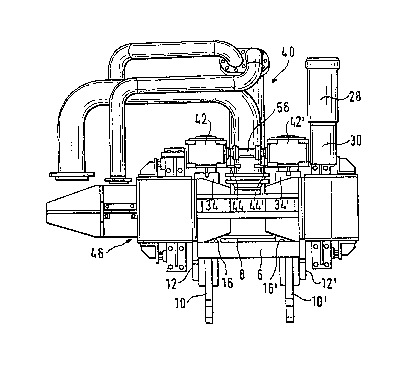Some of the information on this Web page has been provided by external sources. The Government of Canada is not responsible for the accuracy, reliability or currency of the information supplied by external sources. Users wishing to rely upon this information should consult directly with the source of the information. Content provided by external sources is not subject to official languages, privacy and accessibility requirements.
Any discrepancies in the text and image of the Claims and Abstract are due to differing posting times. Text of the Claims and Abstract are posted:
| (12) Patent Application: | (11) CA 2080303 |
|---|---|
| (54) English Title: | DRIVE FOR AUTOMATIC LANCE CHANGE DEVICES |
| (54) French Title: | ENTRAINEMENT POUR MECANISME DE REMPLACEMENT AUTOMATIQUE DE LANCE |
| Status: | Deemed Abandoned and Beyond the Period of Reinstatement - Pending Response to Notice of Disregarded Communication |
| (51) International Patent Classification (IPC): |
|
|---|---|
| (72) Inventors : |
|
| (73) Owners : |
|
| (71) Applicants : | |
| (74) Agent: | GOWLING WLG (CANADA) LLP |
| (74) Associate agent: | |
| (45) Issued: | |
| (22) Filed Date: | 1992-10-09 |
| (41) Open to Public Inspection: | 1993-04-15 |
| Examination requested: | 1999-07-14 |
| Availability of licence: | N/A |
| Dedicated to the Public: | N/A |
| (25) Language of filing: | English |
| Patent Cooperation Treaty (PCT): | No |
|---|
| (30) Application Priority Data: | ||||||
|---|---|---|---|---|---|---|
|
DRIVE FOR AUTOMATIC LANCE CHANGE DEVICES
ABSTRACT
The coupling of lances used for supplying media
by pressing them against a coupling head is effected by
means of draw rods which are operated with the aid of
lifting spindle movement transmitting screw thread
systems. Each draw rod (16, 16') has associated with it
its own reduction gear unit (42, 42') which has an
integrated lifting spindle system and on which a load
cell (34, 34') is mounted. The primary shafts, in
alignment with one another, of the two gear units (42,
42') are connected together by means of a coupling (56)
compensating for axial, radial and angular displacements.
Note: Claims are shown in the official language in which they were submitted.
Note: Descriptions are shown in the official language in which they were submitted.

2024-08-01:As part of the Next Generation Patents (NGP) transition, the Canadian Patents Database (CPD) now contains a more detailed Event History, which replicates the Event Log of our new back-office solution.
Please note that "Inactive:" events refers to events no longer in use in our new back-office solution.
For a clearer understanding of the status of the application/patent presented on this page, the site Disclaimer , as well as the definitions for Patent , Event History , Maintenance Fee and Payment History should be consulted.
| Description | Date |
|---|---|
| Inactive: IPC from MCD | 2006-03-11 |
| Application Not Reinstated by Deadline | 2001-10-09 |
| Time Limit for Reversal Expired | 2001-10-09 |
| Deemed Abandoned - Failure to Respond to Maintenance Fee Notice | 2000-10-10 |
| Amendment Received - Voluntary Amendment | 2000-02-22 |
| Letter Sent | 1999-07-29 |
| Inactive: Application prosecuted on TS as of Log entry date | 1999-07-29 |
| Inactive: Status info is complete as of Log entry date | 1999-07-29 |
| Request for Examination Requirements Determined Compliant | 1999-07-14 |
| All Requirements for Examination Determined Compliant | 1999-07-14 |
| Inactive: Office letter | 1997-10-10 |
| Application Published (Open to Public Inspection) | 1993-04-15 |
| Abandonment Date | Reason | Reinstatement Date |
|---|---|---|
| 2000-10-10 |
The last payment was received on
Note : If the full payment has not been received on or before the date indicated, a further fee may be required which may be one of the following
Please refer to the CIPO Patent Fees web page to see all current fee amounts.
| Fee Type | Anniversary Year | Due Date | Paid Date |
|---|---|---|---|
| MF (application, 5th anniv.) - standard | 05 | 1997-10-09 | 1997-10-02 |
| MF (application, 6th anniv.) - standard | 06 | 1998-10-09 | 1998-09-23 |
| Request for examination - standard | 1999-07-14 | ||
| MF (application, 7th anniv.) - standard | 07 | 1999-10-12 | 1999-10-08 |
| MF (application, 2nd anniv.) - standard | 02 | 1994-10-10 |
Note: Records showing the ownership history in alphabetical order.
| Current Owners on Record |
|---|
| PAUL WURTH S.A. |
| Past Owners on Record |
|---|
| DANIEL FRIES |
| HUBERT STOMP |
| SERGE DEVILLET |